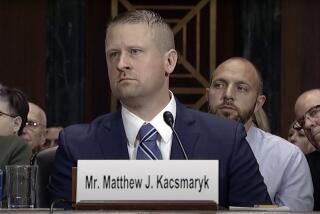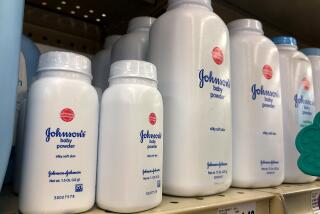Column: Ovarian cancer and talc: Did junk science cost Johnson & Johnson $127 million in court?
- Share via
Johnson & Johnson is an immense pharmaceutical and consumer products company of the type that the public loves to hate. Recently, it’s been getting absolutely killed by juries holding its baby powder responsible for causing several women’s ovarian cancers.
The damage awards levied against Johnson by juries in St. Louis on behalf of two families total $127 million. That sum would suggest that the scientific evidence is clear that Johnson’s talcum powder caused the women’s cancers. But what does science say?
Science says the evidence is murky at best, often self-contradictory, and may well be nonexistent. One study involving more than 100,000 women found “little support for any substantial association” between talc use and overall ovarian cancer risk.
(The verdict) goes against 30 years of studies by medical experts around the world that continue to support the safety of cosmetic talc.
— Johnson & Johnson, responding to a $55-million damages award in a St. Louis court Monday
That’s not how the lawyers who brought the St. Louis cases put it. In a lawsuit filed in Missouri state court in June 2014, they cite a study showing a “92% increased risk in ovarian cancer” among women who reported using talcum power in their genital area. The crux of their case is that their clients’ ovarian cancer was “directly and proximately caused” by Johnson & Johnson’s manufacture and sale of its baby powder and Shower to Shower products, along with marketing that “compelled women” to “dust themselves with this product to mask odors” and help them “feel soft, fresh, and comfortable.”
The plaintiffs, who also are suing Luzenac America, a talc manufacturer, argue that Johnson & Johnson has known since 1971 of a link between ovarian cancer and the application of talc to the genital area. Since the 1980s, the lawsuit says, the companies have been advised by scientists and cancer prevention organizations to warn consumers of the possible risks, but never have done so.
Johnson & Johnson, in response, says that “multiple scientific and regulatory reviews have determined that talc is safe for use in cosmetic products and the labeling on Johnson’s Baby Powder is appropriate.” After a St. Louis jury awarded a South Dakota woman $55 million on Monday, the company said the decision “goes against 30 years of studies by medical experts around the world that continue to support the safety of cosmetic talc.” That verdict followed a $72-million award to another plaintiff in the same court, including $62 million in punitive damages. Johnson faces at least an additional 1,200 lawsuits on similar claims.
Yet taken altogether, these cases raise real questions about whether the American legal system is well-equipped to weigh scientific evidence and assign liability where the facts are, at best, equivocal. Since we aren’t privy to the discussions in the jury rooms, we can’t say for sure what aspects of these cases led the jurors to their punishing conclusions.
It’s quite possible that Johnson & Johnson, as a hugely profitable $70-billion company, was a sitting duck for juror hostility. It’s proper to note that government agencies have accused the company of overly aggressive marketing and promotion of prescription drugs, including dangerous opioids. So it’s also possible that the juries heard convincing evidence that Johnson deliberately downplayed the risks of talc in order to rack up sales.
Perhaps most important, the verdicts may reflect a loss of credibility of scientific evidence in general. Some of the leading research asserting a link between talc and ovarian cancer was done by a scientist who is a paid consultant for the plaintiffs in the St. Louis case; but one of the more comprehensive papers debunking the link was paid for partially by a law firm representing Luzenac. It’s unsurprising that the public, and jurors, don’t know who to believe, if anyone.
Still, the link between talc and ovarian cancer appears to be unproven. Let’s take a look.
Ovarian cancer is relatively rare, accounting for only 1.3% of all new cases in the U.S., according to the National Cancer Institute. But it’s a tenacious killer. It’s the eighth most common cancer and the fifth leading cause of cancer-related death among women. Fewer than half of all patients survive five years after diagnosis.
Most ovarian cancer authorities seem to suggest that any role played by talc in the incidence of ovarian cancer is swamped by more easily identified risk factors. The Ovarian Cancer National Alliance doesn’t list talc at all as a risk factor. Among the main causes of the disease, the organization says, are heredity--mutations in breast cancer gene 1 (BRCA1) or breast cancer gene 2 (BRCA2) are “responsible for about 10 to 15 percent of all ovarian cancers”; obesity; and age -- rates are highest in women aged 55-64. Reproductive history is another factor, with rates elevated among women who have not given birth or taken oral contraceptives.
The American Cancer Society does list talc among these risk factors, but only gingerly, stating that “some studies suggest a very slight increase in risk of ovarian cancer in women who used talc on the genital area” and suggesting that the blame may rest with contamination of talcum powder with asbestos, which is no longer the case.
Patient advocacy groups have been less measured about the risks. In 2010, Samuel Epstein, then chairman of the Cancer Prevention Coalition and a crusader against supposedly carcinogenic consumer products, wrote that ovarian cancer mortality “for women over the age of 65 has increased by 47 percent in African American women and 13 percent in Caucasian women due to genital use of talc powder,” which gave talc prominence as a cause of mortality that doesn’t seem widely supported in the scientific literature.
The scientific findings are all over the map. Among the work most commonly cited by the plaintiffs bar is that of Daniel Cramer, an epidemiologist at Boston’s Brigham and Women’s Hospital, which found a 33% increase in the ovarian cancer rate among women who used talcum power genitally. Cramer is a paid consultant for plaintiffs suing Johnson & Johnson.
Other researchers, including the authors of a paper in the Journal of the American Cancer Society, point to serious flaws in such retrospective case control studies. These rely on subjects to report their past experience, which could be marred by poor recollection or biased by the desire to pinpoint a cause of disease.
More reliable study designs have failed to confirm Cramer’s findings. These include a survey drawn from the Nurses Health Study, which involves 121,000 nurses nationwide, and a second cohort study of nearly 62,000 postmenopausal women led by the University of Massachusetts-Amherst. Neither found any significant connection between talc use and overall incidence of ovarian cancer, although the nurses study found inconclusive hints of a possible association with one variety of ovarian cancer.
Another question is the mechanism of how talc could affect cancer rates. One theory is that talc applied to the genital area could migrate up the female reproductive tract to the ovaries, causing inflammation leading to cancer, but that process is unproven. Nor have studies established a link between talc-dusted diaphragms or condoms and ovarian cancer risk, which should appear if talc really is a significant culprit.
So the link between talcum powder use and ovarian cancer hasn’t been proved, but hasn’t been conclusively debunked, either. That places it right in the danger zone of product liability litigation, especially when scientists on either side of the debate affiliate themselves with lawyers on either side. (A paper challenging the scientific basis for the link was produced on a contract from Crowell Moring, the law firm representing Luzenac.)
Big damage awards based on equivocal scientific evidence aren’t good for anyone. They’re vulnerable to being overturned or significantly pared down. They generate public fears that may be unwarranted. The litigation process itself undermines the credibility of scientists across the spectrum of debate. And they contribute nothing to the fundamental issue of corporate responsibility: When should a company such as Johnson & Johnson disclose the putative risk of a product?
The talc lawsuits are a disturbing example of a judicial system that imposes certainty where there isn’t any. Jurors in the courthouse were sure enough about the link to slap Johnson & Johnson with $127 million in damages, even though the scientific jury is still out.
Keep up to date with Michael Hiltzik. Follow @hiltzikm on Twitter, see his Facebook page, or email [email protected].
Return to Michael Hiltzik’s blog.
More to Read
Inside the business of entertainment
The Wide Shot brings you news, analysis and insights on everything from streaming wars to production — and what it all means for the future.
You may occasionally receive promotional content from the Los Angeles Times.











